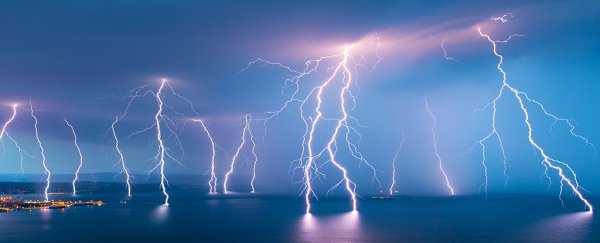There's something about the meandering streak of lightning that implies random chaos. Yet bolts from the blue not only hit the same places with regularity, but successive discharges often reuse the exact same channel.
It's never been entirely clear how the path laid down by one bolt sticks around for repeat performances, but new research has discovered lingering pockets of charge in the wake of a single lightning strike, which could provide a map for more to follow.
An international team of physicists collected an unprecedented level of detail on radio waves emitted by lightning to determine why the charged pockets of air setting out lightning's path behave the way they do.
Using a radio telescope network called the Low-Frequency Array, or LOFAR, researchers were able to gather data that provided nanosecond resolution of strikes across an area of several thousand square kilometres.
"These data allow us to detect lightning propagation at a scale where, for the first time, we can distinguish the primary processes," says physicist Brian Hare from the University of Groningen in the Netherlands.
"Furthermore, the use of radio waves allows us to look inside the thundercloud, where most of the lightning resides."
For all its impressive flashing and booming, lightning is really just a grandaddy electrical spark caused by a difference in positive and negative charges.
Those opposing charges are separated by air currents whipping around bits of hail called graupel, causing them to physically bump and grind their electrons apart in a meteorological game of pass the parcel.
A steady accumulation of hundreds of millions of volts can arise within and between separate clouds, or between a cloud and the ground. Wherever it forms, though, lightning has an opportunity to leap, but only if the conditions are right.
What we see as the zig-zagging bolt is merely the end of a complex process we're still piecing together.
The first step involves the formation of a small pocket of plasma – a blob of heated gas comprised of charged particles. This tiny lightning seed quickly branches out in many directions, with one or more forming a channel kilometres in length that acts like a giant wire strung across the sky.
Ends of this channel, called leaders, can be positive or negative, each of which move in unique ways depending on their charge.
Negative leaders tend to move in a discontinuous fashion referred to as stepping, producing a high-frequency radio signal as they jump. Positive leaders don't step in the same way, so don't produce the same signal as they grow. Yet their channels still hum with a distinctive pattern in radio waves.
These contrasting signals provide researchers with insight into the lightning's rapid generation, from the plasma channel's growth to the climactic light show at the end.
One curious observation made in the past has been positive leaders can become separated from their plasma channel. Nobody knows why this split occurs as it does, largely because most studies to date have lacked the necessary resolution.
The vast complex of antennae making up LOFAR though has provided researchers just what they need to zero in on the fine details of a branching plasma channel.
"Close to the core area of LOFAR, where the antenna density is highest, the spatial accuracy was about one metre", says University of Groningen physicist Olaf Scholten.
With such a fine level of detail, the researchers were able to map the dynamic changes occurring within the plasma channels as they reached out, and this enabled the team to make a rather strange discovery.
As leaders arrive at areas with a sufficient difference in voltage, electrons surge through the plasma, baking the air to temperatures hotter than the surface of the Sun.
It turns out not all of this current makes its way to the same end points. Some residual charge leaks out through breaks in the main discharge channel, hanging around in small, thin structures dubbed needles.
"This finding is in sharp contrast to the present picture, in which the charge flows along plasma channels directly from one part of the cloud to another, or to the ground," says Scholten.
"These needles can have a length of 100 metres and a diameter of less than five metres, and are too small and too short-lived for other lightning detections systems," adds Hare.
Should the voltage difference build again in the cloud in a relatively short amount of time, these charged needles can provide a map for further strikes, explaining why we might often see copy-cat lightning bolts hit the same mark repeatedly.
The clip below shows a strike forming in slow motion, with each yellow dot portraying a radio pulse describing the path of the pending discharge. At the very top of the clip you can see the positive leaders twinkling as they encounter needles from a previous bolt.
"From these observations, we see that a part of the cloud is re-charged, and we can understand why a lightning discharge to the ground may repeat itself a few times," says Hare.
For such a primal force we've marvelled at forever, it's amazing to think we're still learning so much about how lightning works.
This research was published in Nature.
